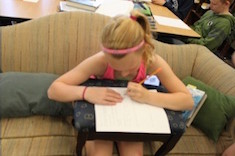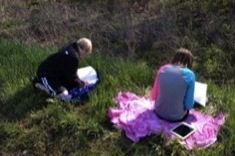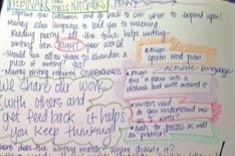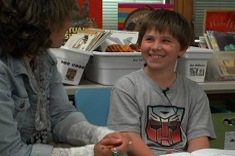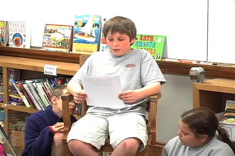Last summer I stumbled across Linda Rief’s book, 100 Quickwrites: Fast and Effective Freewriting Exercises That Build Students’ Confidence, Develop Their Fluency, and Bring Out the Writer in Every Student. I had not heard of quick-writes, so I was intrigued. In the book Rief shares poems, short stories, and short texts with her students. After reading the text to them, they write for a short burst of time, reacting either to the text or to a question she has posed. I found it to be a powerful idea and decided to try it with my students this year.
In my classroom we do a quick-write for the first few minutes of each class. Although the “text” we might be using changes, the procedures do not. We begin by gathering at the carpet with our notebooks and pencils. The students find a spot in their notebook to label with the date and “QW” or “quick-write.” I share the text for the day and then give them a set amount of time to write, usually two to three minutes.
The texts I use vary daily. Most weeks follow the schedule below:
Monday: Images
Tuesday: Picture Books
Wednesday: Articles
Thursday: Videos
Friday: Poetry
Compiling sources is an ongoing endeavor. After a year of using quick-writes, here are some sources I return to again and again.
Images
Images are one of my favorite pieces to quick-write from. All students can easily access this text, and it creates a natural opportunity to infer. Some places I pull images from to use:
- Photos Framed: A Fresh Look at the World’s Most Memorable Photographs by Ruth Thomson. This is a fabulous collection of famous photographs and the stories behind them.
- The Twitter account History in Pictures (@HistoryInPics). Caution: Not all are student-friendly, so make sure you preview them first.
- The Daily Infographic, http://www.dailyinfographic.com
- The Wordless News, http://wordlessnews.com
- Instagram accounts for National Geographic (@natgeo) and the U.S. Department of the Interior (@usinterior)
- “What’s Going On in This Picture?” from the New York Times
- Lens blog from the New York Times
Picture Books
I use a variety of picture books through the year, often as an introduction to a topic that I want to explore further. I use the picture books as my road in, to activate background knowledge and inspire the students to want to learn more. Sometimes I simply use this format to ask what feelings or emotions the book inspires, or what their reaction was to it. The number I use would be too many to include here, but here are a few examples:
- Sidewalk Flowers by JonArno Lawson to simply write about the feelings the book inspired.
- I Yam a Donkey! by Cece Bell to look at the importance of audience and word choice.
- Courage by Bernard Waber to write about our feelings of courage or a time we were courageous.
Articles
Many websites have articles that are the perfect length to use as a quick-write: long enough to teach us some information, but short enough to read at the start of class. My favorite sites to visit again and again include these:
Videos
Whether they are videos pulled from Wonderopolis or YouTube, or clips I have found elsewhere, short video clips captivate my students like nothing else. They often don’t think they are learning when they are watching videos, but they truly are. For sources, I pay attention to commercials, videos people are sharing on Facebook about kindness, and ones I stumble across. Here is the link to my Pinterest board where I try to collect all the videos I would like to use. The website The Kids Should See This also has a collection of great videos.
Some words of caution with videos:
- Sometimes links expire unexpectedly. Always revisit your video just before the lesson to make sure it is still available.
- Watch the entire video before using it in your classroom. Some of the videos on my Pinterest page I use only parts of; either they are too long or there is something I don’t want my students to see.
- When watching videos on YouTube, you cannot control the thumbnails at the end of the video or the comments below. Sometimes these are also items you don’t want your students to see. You can adjust the size of the video on your screen so the comments are not visible. To avoid the thumbnails, simply hit “pause” before the end of the video.
Poetry
I think poetry is underused in our classrooms. Often it is relegated to April for Poetry Month, when we could gain so much from daily use. I have several books I take poems from, but here are some anthologies I pull from on a weekly basis:
- Linda Reif’s book mentioned above, 100 Quickwrites, has several wonderful poems.
- The Poetry Friday anthologies are wonderful: The Poetry Friday Anthology, The Poetry Friday Anthology for Science, and The Poetry Friday Anthology for Celebrations.
- The Death of the Hat: A Brief History of Poetry in 50 Objects selected by Paul Janeczko
- UnBEElievables: Honeybee Poems and Paintings by Douglas Florian
- A Writing Kind of Day: Poems for Young Poets by Ralph Fletcher
What I have noticed from a year of daily writing, even for only two to three minutes at a time, is growth. At the start of the year, I would have several children in each class who couldn’t start right away or would stop writing after a minute. Often a sentence, they thought, was enough. I would prompt them to keep their pencil flowing and see what happened.
By the end of the year after sharing our text, I would pull the time up on my phone and say, “Three, two, one, write!” There would be immediate silence as everyone fell to writing. No longer was there a student who didn’t begin immediately. Rather than stopping after a minute or a sentence, there would be groans when I called time and frequently half of a page or more would be filled. I would remind them that if they did a quick-write that called to them, asking to be continued, they were welcome to do so in their writing later—and many children would do just that.
Even more telling was that quick-writes were listed by many as one of their favorite writing activities of the year. Children said it helped them to learn how to get started and inspired them to write more. I highly encourage you to try quick-writes in your classroom. From such a small activity, you can see wonderful results.

